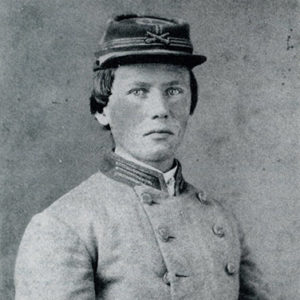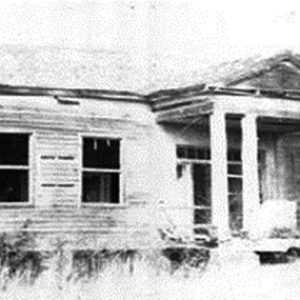calsfoundation@cals.org
William Pratt "Buck" Parks (1843–1907)
William Pratt “Buck” Parks was a captain of a heavy artillery battery at the Battle of Vicksburg in Mississippi. Following the Civil War, Parks became a prominent leader of agrarian protest in Arkansas.
The 1860 Census shows William Pratt Parks living in Little Rock (Pulaski County) at the residence of Joshua and Susan Jones, along with four younger siblings. A newspaper article appearing in the Arkansas Gazette on May 16, 1911, listed Parks as being enrolled at St. Johns’ College when it first opened, in October 1859. Parks served as a private in the Pulaski County Field Artillery Battery (Arkansas state troops). This battery, originally organized in late 1860 as the Totten Light Battery, became the Pulaski County Field Artillery Battery in May 1861 under the command of Captain William E. Woodruff Jr. This battery fought at the Battle of Wilson’s Creek on August 10, 1861. Following this engagement, the Arkansas state troops were disbanded to prevent their being impressed into Confederate service and potentially being transferred east of the Mississippi River.
In October 1861, Parks signed up with Company D, Fourth Arkansas Infantry Battalion (CS). On December 3, he was appointed a first lieutenant of that unit. Soon afterward, Company D was detached from the Fourth Battalion to serve in the heavy artillery. The unit was transferred from the Arkansas service to that of Tennessee. The first recorded action fought by this unit, Captain Frederick W. Hoadley’s Heavy Artillery Battery, was in the New Madrid–Island No. 10 Campaign from February to April 1862. This campaign resulted in Confederate defeat, and the battery suffered a severe loss of men and equipment.
During May and June 1862, the Tennessee heavy artillery units stationed at Vicksburg were reorganized as the First Tennessee Heavy Artillery Regiment (CS). The remainder of Hoadley’s Battery was merged with the remnants of two Tennessee batteries and part of another. On May 10, Parks was chosen as the captain of the new battery, while Hoadley was promoted to the rank of regimental major. At about this time, Parks was serving as a volunteer aboard the Confederate ship CSS Arkansas. Through summer and fall of 1862, Parks’s Battery periodically exchanged fire with the Union fleet on the Mississippi River.
Although Parks’s career was on the rise, his health did not keep pace. During November and December 1862, he was frequently ill, and he was relieved of command in January 1863. By March 14, he was back on active duty as a quartermaster at Vicksburg. His battery was reportedly involved in the sinking of the USS Cincinnati on May 27, 1863. He was captured when Vicksburg fell on July 4. According to a later newspaper account, Parks returned to Little Rock after the war and worked for a time in the law office of Augustus Garland, later the governor of Arkansas. He then moved to Lewisville (Lafayette County), where he opened a law office and owned a farm. He married Mattie Douglass in 1866.
Parks then became a leader of the discontented farmers against the Democratic Party elite in Arkansas. In 1880, Parks was also the Greenback Party nominee for governor of Arkansas. He had the endorsement of the Arkansas Republican Party but received only a third of the vote. In 1882, Parks traveled to southern Arkansas campaigning for Greenbackers, although he does not seem to have been a candidate.
In 1884, he purchased an interest in the Hope Dispatch, a radical farmer newspaper. In 1892, he ran as the Populist Party nominee for state attorney general and lost. In 1896, Parks was a member of the Populist Party’s state convention’s committee on resolutions and was a delegate to the Populist national convention. He was also involved in an effort to purchase land in Texarkana (Miller County) through a tax sale, although the previous owner challenged the sale in court; the 1889 case of Jared E. Redfield v. W. P. Parks was decided against Parks. The 1900 Census has Parks still living in Lafayette County, working as a lawyer and owning a farm.
Parks died on June 13, 1907, at his home near Lewisville. He was survived by his wife and four children. His son Tilman B. Parks served in the U.S. House of Representatives from 1921 to 1936.
Parks is buried at the Cryer Cemetery at Clifton Grove near Lewisville.
For additional information:
“Arkansan in One of Most Daring Naval Feats in History of World.” Arkansas Gazette. May 16, 1911, p. 17.
Barjenbruck, Judith. “The Greenback Political Movement: An Arkansas View.” Arkansas Historical Quarterly 36 (Summer 1977): 107–122.
“Deaths and Funerals: Capt. W. P. Parks.” Arkansas Gazette. June 14, 1907, p. 7.
Woodruff, William E. With the Light Guns in ’61–’65: Reminiscences of Eleven Arkansas, Missouri and Texas Light Batteries in the Civil War. Little Rock: Central Printing Company, 1903.
Charles Rector
Woodstock, Illinois
 Military
Military William Parks
William Parks  William Parks
William Parks  Parks-Cryer House
Parks-Cryer House 




An article in Mississippi River Routes, Volume 20, No 4, by Sue Burns Moore includes a footnote regarding a letter that Captain Parks wrote to President Jefferson Davis, on the occasion of Davis’s 80th birthday, in which Parks describes the role that his battery played in the sinking of the Union Ironclad Cincinnati on May 27, 1863. Parks also describes how he was accused of breaking the truce between General Pemberton and General Grant on July 3, 1863, the evening prior to the formal surrender of Vicksburg. It appears that Parks spotted Union soldiers attempting to use guns salvaged from the Cincinnati to erect a new battery during the truce. Parks immediately engaged the work party until he was ordered to stop by General Pemberton. The footnote for the letter to Davis from Parks is Jefferson Davis and Dunbar, Rowland, Jefferson Davis, Constitutionalist: His Letters, Papers, and Speeches (Jackson: Mississippi Department of Archives and History, 1923), pp. 68-72. The firing was noted in communications that evening between General Grant and General Sherman. OR, Series 1, Vol. 24, part 3, page 462 July 3, 1863 The news is so good I can hardly believe it, and I am confused by the sound of cannon at Vicksburg this p. m. Signed W. T. Sherman – Page 463 OAK RIDGE, July 3, 1863. General GRANT: General Sherman desires me to ask what means the heavy firing at Vicksburg. JNO. G. PARKE. NEAR Vicksburg, July 3, 1863. General PARKE: Flag of truce only covered bearer of dispatches; firing was continued by balance of the line. U.S. GRANT Parks resumed command of his unit prior to the end of the siege, and Parks unit exchanged fire with Union ships in 1863, not 1862. The Pulaski Light Artillery was actually formed in December 1860.